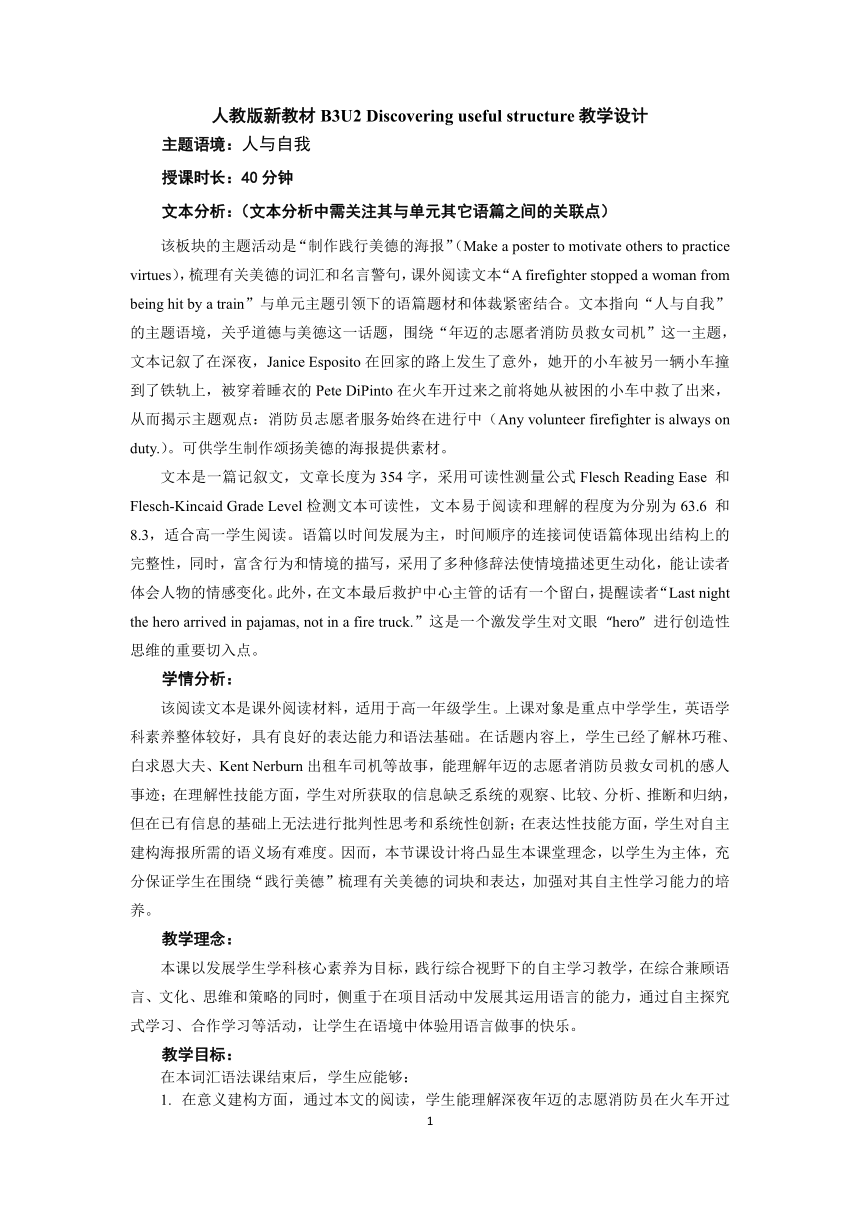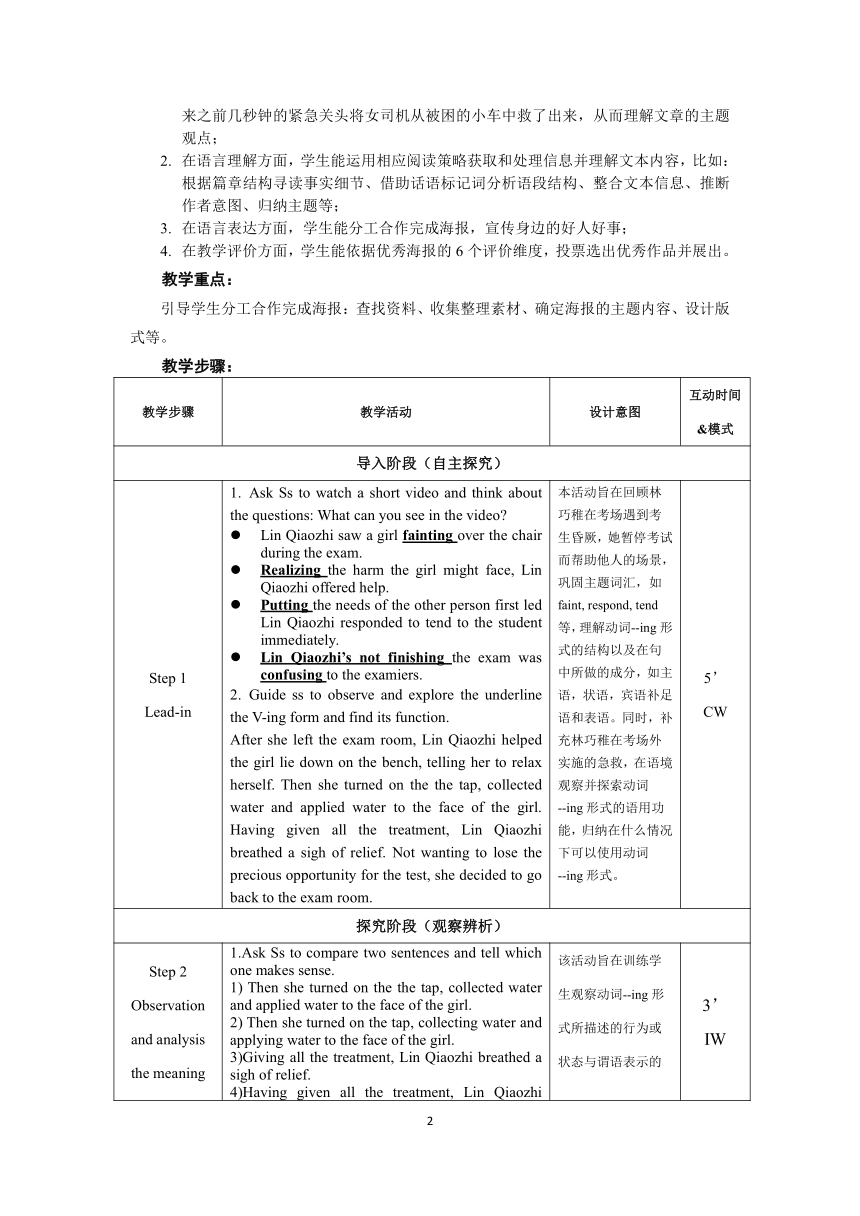人教版(2019)必修第三册 Unit 2 Morals and Virtues Discovering useful structure 教学设计(表格式)
文档属性
| 名称 | 人教版(2019)必修第三册 Unit 2 Morals and Virtues Discovering useful structure 教学设计(表格式) |

|
|
| 格式 | docx | ||
| 文件大小 | 25.5KB | ||
| 资源类型 | 教案 | ||
| 版本资源 | 人教版(2019) | ||
| 科目 | 英语 | ||
| 更新时间 | 2023-07-23 19:08:48 | ||
图片预览


文档简介
人教版新教材B3U2 Discovering useful structure教学设计
主题语境:人与自我
授课时长:40分钟
文本分析:(文本分析中需关注其与单元其它语篇之间的关联点)
该板块的主题活动是“制作践行美德的海报”(Make a poster to motivate others to practice virtues),梳理有关美德的词汇和名言警句,课外阅读文本“A firefighter stopped a woman from being hit by a train”与单元主题引领下的语篇题材和体裁紧密结合。文本指向“人与自我”的主题语境,关乎道德与美德这一话题,围绕“年迈的志愿者消防员救女司机”这一主题,文本记叙了在深夜,Janice Esposito在回家的路上发生了意外,她开的小车被另一辆小车撞到了铁轨上,被穿着睡衣的Pete DiPinto在火车开过来之前将她从被困的小车中救了出来,从而揭示主题观点:消防员志愿者服务始终在进行中(Any volunteer firefighter is always on duty.)。可供学生制作颂扬美德的海报提供素材。
文本是一篇记叙文,文章长度为354字,采用可读性测量公式Flesch Reading Ease 和Flesch-Kincaid Grade Level检测文本可读性,文本易于阅读和理解的程度为分别为63.6 和8.3,适合高一学生阅读。语篇以时间发展为主,时间顺序的连接词使语篇体现出结构上的完整性,同时,富含行为和情境的描写,采用了多种修辞法使情境描述更生动化,能让读者体会人物的情感变化。此外,在文本最后救护中心主管的话有一个留白,提醒读者“Last night the hero arrived in pajamas, not in a fire truck.”这是一个激发学生对文眼 “hero” 进行创造性思维的重要切入点。
学情分析:
该阅读文本是课外阅读材料,适用于高一年级学生。上课对象是重点中学学生,英语学科素养整体较好,具有良好的表达能力和语法基础。在话题内容上,学生已经了解林巧稚、白求恩大夫、Kent Nerburn出租车司机等故事,能理解年迈的志愿者消防员救女司机的感人事迹;在理解性技能方面,学生对所获取的信息缺乏系统的观察、比较、分析、推断和归纳,但在已有信息的基础上无法进行批判性思考和系统性创新;在表达性技能方面,学生对自主建构海报所需的语义场有难度。因而,本节课设计将凸显生本课堂理念,以学生为主体,充分保证学生在围绕“践行美德”梳理有关美德的词块和表达,加强对其自主性学习能力的培养。
教学理念:
本课以发展学生学科核心素养为目标,践行综合视野下的自主学习教学,在综合兼顾语言、文化、思维和策略的同时,侧重于在项目活动中发展其运用语言的能力,通过自主探究式学习、合作学习等活动,让学生在语境中体验用语言做事的快乐。
教学目标:
在本词汇语法课结束后,学生应能够:
在意义建构方面,通过本文的阅读,学生能理解深夜年迈的志愿消防员在火车开过来之前几秒钟的紧急关头将女司机从被困的小车中救了出来,从而理解文章的主题观点;
在语言理解方面,学生能运用相应阅读策略获取和处理信息并理解文本内容,比如:根据篇章结构寻读事实细节、借助话语标记词分析语段结构、整合文本信息、推断作者意图、归纳主题等;
在语言表达方面,学生能分工合作完成海报,宣传身边的好人好事;
在教学评价方面,学生能依据优秀海报的6个评价维度,投票选出优秀作品并展出。
教学重点:
引导学生分工合作完成海报:查找资料、收集整理素材、确定海报的主题内容、设计版式等。
教学步骤:
教学步骤 教学活动 设计意图 互动时间&模式
导入阶段(自主探究)
Step 1 Lead-in Ask Ss to watch a short video and think about the questions: What can you see in the video Lin Qiaozhi saw a girl fainting over the chair during the exam. Realizing the harm the girl might face, Lin Qiaozhi offered help. Putting the needs of the other person first led Lin Qiaozhi responded to tend to the student immediately. Lin Qiaozhi’s not finishing the exam was confusing to the examiers. Guide ss to observe and explore the underline the V-ing form and find its function. After she left the exam room, Lin Qiaozhi helped the girl lie down on the bench, telling her to relax herself. Then she turned on the the tap, collected water and applied water to the face of the girl. Having given all the treatment, Lin Qiaozhi breathed a sigh of relief. Not wanting to lose the precious opportunity for the test, she decided to go back to the exam room. 本活动旨在回顾林巧稚在考场遇到考生昏厥,她暂停考试而帮助他人的场景,巩固主题词汇,如faint, respond, tend 等,理解动词--ing形式的结构以及在句中所做的成分,如主语,状语,宾语补足语和表语。同时,补充林巧稚在考场外实施的急救,在语境观察并探索动词--ing形式的语用功能,归纳在什么情况下可以使用动词--ing形式。 5’ CW
探究阶段(观察辨析)
Step 2 Observation and analysis the meaning and useage of ving form 1.Ask Ss to compare two sentences and tell which one makes sense. 1) Then she turned on the the tap, collected water and applied water to the face of the girl. 2) Then she turned on the tap, collecting water and applying water to the face of the girl. 3)Giving all the treatment, Lin Qiaozhi breathed a sigh of relief. 4)Having given all the treatment, Lin Qiaozhi breathed a sigh of relief. 5) We can see Lin Qiaozhi holding a baby and smiling. 6) We can see Lin Qiaozhi hold a baby and smile. 7) Lin Qiaozhi always had herself work around the clock. 8) Lin Qiaozhi always had herself working around the clock. 2.Complete the conversations using the correct forms of the words in the barackets.(WB P68) 该活动旨在训练学生观察动词--ing形式所描述的行为或状态与谓语表示的动作之间的逻辑关系,时间先后关系,以及作做宾语补足语时动作的瞬间性和延续性。 3’ IW
Step 3 Understanding the function of Ving form Activity1: Ask ss to read the following story and answer the follwing questions. Guiding questions: ①Why did Dr Bethune come to China ②How did he help the Chinese people during the war ③What did Chairman Mao Zhedong say about him Activity 2: Request ss to rewrite the underlined parts using the –ing form. Activity 3: Encourage ss to discover the diffence of two versions. 活动1检测学生是否理解语篇内容,意在通过信息的获取梳理与解读;活动2 检测学生是否能用动词--ing形式改写部分句子,并说明其功能;活动3引导学生观察改写后的句子和原句,比较两种写法的不同,体会动词--ing形式使行文更流畅、表达更丰富、文章更具文采。 10’ CW IW
巩固阶段(应用实践)
Step 4 Practice Activity 1: Guide Ss to rewrite the following sentences using the –ing form or the past participle as the adverbial. Activity 2: Encourage Ss to complete the passage using the –ing form or the part participle of the verbs in the box. 活动1依托深化理解类语法练习活动,通过改写句子,深度分析现在分词与过去分词做状语的区别;活动2聚焦现在分词与过去分词的意义和语用功能。 10’ IW PW CW
运用阶段 (迁移创新)
Step 5 Homework Ask ss to watch five minutes of a cartoon, a documentary, or a film and take notes on what happened. Then write a paragraph describing the actions of the characters. Using the –ing from in your description. 基于所创设情境,依托建构创造类输出活动,迁移、运用主题内容及语言,建构新语篇。
备注:Ss: Students IW: Individual work GW: Group work CW: Class work
板书设计:
(
see/find/notice/watch/look at/hear/
listen to/feel sb doing
have/get/leave/keep/set sb doing
With sb helping/encouraging me, S+V…
)Using -ing form as the object complement and the adverbial
Using -ing form as the object complement
(
(not) V-ing, S + V…
(not) having done, S + V…
)
Using -ing form as the adverbial
1
主题语境:人与自我
授课时长:40分钟
文本分析:(文本分析中需关注其与单元其它语篇之间的关联点)
该板块的主题活动是“制作践行美德的海报”(Make a poster to motivate others to practice virtues),梳理有关美德的词汇和名言警句,课外阅读文本“A firefighter stopped a woman from being hit by a train”与单元主题引领下的语篇题材和体裁紧密结合。文本指向“人与自我”的主题语境,关乎道德与美德这一话题,围绕“年迈的志愿者消防员救女司机”这一主题,文本记叙了在深夜,Janice Esposito在回家的路上发生了意外,她开的小车被另一辆小车撞到了铁轨上,被穿着睡衣的Pete DiPinto在火车开过来之前将她从被困的小车中救了出来,从而揭示主题观点:消防员志愿者服务始终在进行中(Any volunteer firefighter is always on duty.)。可供学生制作颂扬美德的海报提供素材。
文本是一篇记叙文,文章长度为354字,采用可读性测量公式Flesch Reading Ease 和Flesch-Kincaid Grade Level检测文本可读性,文本易于阅读和理解的程度为分别为63.6 和8.3,适合高一学生阅读。语篇以时间发展为主,时间顺序的连接词使语篇体现出结构上的完整性,同时,富含行为和情境的描写,采用了多种修辞法使情境描述更生动化,能让读者体会人物的情感变化。此外,在文本最后救护中心主管的话有一个留白,提醒读者“Last night the hero arrived in pajamas, not in a fire truck.”这是一个激发学生对文眼 “hero” 进行创造性思维的重要切入点。
学情分析:
该阅读文本是课外阅读材料,适用于高一年级学生。上课对象是重点中学学生,英语学科素养整体较好,具有良好的表达能力和语法基础。在话题内容上,学生已经了解林巧稚、白求恩大夫、Kent Nerburn出租车司机等故事,能理解年迈的志愿者消防员救女司机的感人事迹;在理解性技能方面,学生对所获取的信息缺乏系统的观察、比较、分析、推断和归纳,但在已有信息的基础上无法进行批判性思考和系统性创新;在表达性技能方面,学生对自主建构海报所需的语义场有难度。因而,本节课设计将凸显生本课堂理念,以学生为主体,充分保证学生在围绕“践行美德”梳理有关美德的词块和表达,加强对其自主性学习能力的培养。
教学理念:
本课以发展学生学科核心素养为目标,践行综合视野下的自主学习教学,在综合兼顾语言、文化、思维和策略的同时,侧重于在项目活动中发展其运用语言的能力,通过自主探究式学习、合作学习等活动,让学生在语境中体验用语言做事的快乐。
教学目标:
在本词汇语法课结束后,学生应能够:
在意义建构方面,通过本文的阅读,学生能理解深夜年迈的志愿消防员在火车开过来之前几秒钟的紧急关头将女司机从被困的小车中救了出来,从而理解文章的主题观点;
在语言理解方面,学生能运用相应阅读策略获取和处理信息并理解文本内容,比如:根据篇章结构寻读事实细节、借助话语标记词分析语段结构、整合文本信息、推断作者意图、归纳主题等;
在语言表达方面,学生能分工合作完成海报,宣传身边的好人好事;
在教学评价方面,学生能依据优秀海报的6个评价维度,投票选出优秀作品并展出。
教学重点:
引导学生分工合作完成海报:查找资料、收集整理素材、确定海报的主题内容、设计版式等。
教学步骤:
教学步骤 教学活动 设计意图 互动时间&模式
导入阶段(自主探究)
Step 1 Lead-in Ask Ss to watch a short video and think about the questions: What can you see in the video Lin Qiaozhi saw a girl fainting over the chair during the exam. Realizing the harm the girl might face, Lin Qiaozhi offered help. Putting the needs of the other person first led Lin Qiaozhi responded to tend to the student immediately. Lin Qiaozhi’s not finishing the exam was confusing to the examiers. Guide ss to observe and explore the underline the V-ing form and find its function. After she left the exam room, Lin Qiaozhi helped the girl lie down on the bench, telling her to relax herself. Then she turned on the the tap, collected water and applied water to the face of the girl. Having given all the treatment, Lin Qiaozhi breathed a sigh of relief. Not wanting to lose the precious opportunity for the test, she decided to go back to the exam room. 本活动旨在回顾林巧稚在考场遇到考生昏厥,她暂停考试而帮助他人的场景,巩固主题词汇,如faint, respond, tend 等,理解动词--ing形式的结构以及在句中所做的成分,如主语,状语,宾语补足语和表语。同时,补充林巧稚在考场外实施的急救,在语境观察并探索动词--ing形式的语用功能,归纳在什么情况下可以使用动词--ing形式。 5’ CW
探究阶段(观察辨析)
Step 2 Observation and analysis the meaning and useage of ving form 1.Ask Ss to compare two sentences and tell which one makes sense. 1) Then she turned on the the tap, collected water and applied water to the face of the girl. 2) Then she turned on the tap, collecting water and applying water to the face of the girl. 3)Giving all the treatment, Lin Qiaozhi breathed a sigh of relief. 4)Having given all the treatment, Lin Qiaozhi breathed a sigh of relief. 5) We can see Lin Qiaozhi holding a baby and smiling. 6) We can see Lin Qiaozhi hold a baby and smile. 7) Lin Qiaozhi always had herself work around the clock. 8) Lin Qiaozhi always had herself working around the clock. 2.Complete the conversations using the correct forms of the words in the barackets.(WB P68) 该活动旨在训练学生观察动词--ing形式所描述的行为或状态与谓语表示的动作之间的逻辑关系,时间先后关系,以及作做宾语补足语时动作的瞬间性和延续性。 3’ IW
Step 3 Understanding the function of Ving form Activity1: Ask ss to read the following story and answer the follwing questions. Guiding questions: ①Why did Dr Bethune come to China ②How did he help the Chinese people during the war ③What did Chairman Mao Zhedong say about him Activity 2: Request ss to rewrite the underlined parts using the –ing form. Activity 3: Encourage ss to discover the diffence of two versions. 活动1检测学生是否理解语篇内容,意在通过信息的获取梳理与解读;活动2 检测学生是否能用动词--ing形式改写部分句子,并说明其功能;活动3引导学生观察改写后的句子和原句,比较两种写法的不同,体会动词--ing形式使行文更流畅、表达更丰富、文章更具文采。 10’ CW IW
巩固阶段(应用实践)
Step 4 Practice Activity 1: Guide Ss to rewrite the following sentences using the –ing form or the past participle as the adverbial. Activity 2: Encourage Ss to complete the passage using the –ing form or the part participle of the verbs in the box. 活动1依托深化理解类语法练习活动,通过改写句子,深度分析现在分词与过去分词做状语的区别;活动2聚焦现在分词与过去分词的意义和语用功能。 10’ IW PW CW
运用阶段 (迁移创新)
Step 5 Homework Ask ss to watch five minutes of a cartoon, a documentary, or a film and take notes on what happened. Then write a paragraph describing the actions of the characters. Using the –ing from in your description. 基于所创设情境,依托建构创造类输出活动,迁移、运用主题内容及语言,建构新语篇。
备注:Ss: Students IW: Individual work GW: Group work CW: Class work
板书设计:
(
see/find/notice/watch/look at/hear/
listen to/feel sb doing
have/get/leave/keep/set sb doing
With sb helping/encouraging me, S+V…
)Using -ing form as the object complement and the adverbial
Using -ing form as the object complement
(
(not) V-ing, S + V…
(not) having done, S + V…
)
Using -ing form as the adverbial
1
